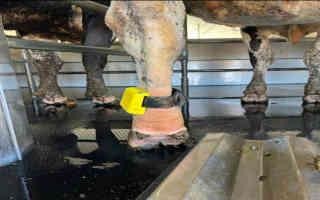By Stacy Nick
Bovine mastitis continues to be one of the most common and costly diseases in the dairy industry, particularly on the organic side where prevention and treatment options are limited.
In an effort to support research in this area, the U.S. Department of Agriculture’s National Institute of Food and Agriculture has awarded a $3 million grant to a multi-state team led by Dr. Pablo Pinedo, a D.V.M. and associate professor in the Department of Animal Sciences at Colorado State University.
As part of a four-year study, a team that includes collaborating researchers from the University of Florida, The Ohio State University, Cornell University, the University of Minnesota and the University of Wisconsin will look at identifying and developing cost-effective management solutions to control mastitis, improve milk quality, promote animal welfare and enhance the sustainability of the organic dairy community.
“The overall goal is to develop and assess an integrated systems approach for mastitis control and welfare,” Pinedo said.
Mastitis, an inflammation of the mammary gland, is often caused by trauma or infection. The condition can impact both milk quantity and quality and is one of the top reasons for early removal of cows within U.S. organic herds.
“One of the most common treatments for mastitis is antibiotics,” Pinedo said. “While conventional farms can use antibiotics, their use is prohibited in organic farms that have fewer options.”
Partnering up
A challenge in this type of research is that organic dairies are typically much smaller than conventional outfits, making it hard to find animal populations large enough to complete field scientific research.

To aid with that, CSU is partnering with a long-time collaborator, Aurora Organic Dairy, which will make its dairies in Colorado available to complete field studies, testing new strategies for mastitis prevention during the dry-off period (the six to eight weeks before calving when cows are not milked). In addition, new research investigating the impact of cow comfort on mastitis occurrence will be completed at these farms.
“I’m thrilled that CSU, with the leadership of Dr. Pablo Pinedo, is leading this study,” said Aurora Organic Dairy Chief Agricultural Officer Dr. Juan Velez. “The grant could not be in better hands, and the collaborations that are taking place in this project will ensure its success.”
A key component of this study consists of visits and surveys to a significant number of smaller organic dairy operations across the country to identify risk factors and management practices that may impact the levels of mastitis. This part of the project will be supported by the veterinary team at Organic Valley Cooperative, facilitating the logistics connecting the team with organic dairy farmers.
An ounce of prevention
With limited treatment options, preventing illness is the number one tool available in the organic dairy industry, Velez said.
To that end, major elements of the study will include identifying best practices and researching the efficacy of preventative methodologies and natural products — such as essential oils and vitamins.
“These products are believed to have some antimicrobial capabilities — as well as the ability to increase the cow’s immune response — but lack much research behind them,” Velez said. “One of the reasons I believe this project is so important is that it will help uncover if the science is solid behind products that are already available.”
Additionally, the benefits of this new information are not restricted to organic dairies, he added. These practices can easily be translated to the conventional dairy industry.
Fitbits for cows
Another element of the study will focus on assessing how improved comfort for the cows overall could help reduce the number of cases of mastitis.

“This is a novel approach because now we have technologies to measure cow comfort, and we are realizing that it is a huge factor that could help cows stay healthy,” Pinedo said.
Data will be collected from approximately 5,000 dairy cows outfitted with special sensors that provide continuous activity levels. Just as Fitbits and Apple Watches collect real-time data on how much people walk, stand and sleep, these sensors will track the cows’ daily movements.
“Using this activity data will help us learn if changes in cow behavior could be predictors to cows getting mastitis, detecting the mastitis and detecting it earlier than you would with the traditional method of just checking a few squirts of milk during milking,” Velez said.
By tracking how many steps a cow is walking, how much time it spends lying down, how much time eating, etc., researchers can see not only how the cow is managing its time but also how healthy it is.
“We know that a lactating dairy cow needs to spend about 11 hours just resting,” Pinedo said. “If she’s not; something is wrong. It could be that there are not enough beds, or the beds are not comfortable. Or maybe she’s resting too long, which might mean she’s starting to get sick.”
The true cost of mastitis
While the disease is known to have a significant impact on dairy operations with annual costs estimated in the billions, the full cost for the organic industry in cows leaving the farm, treatments and milk that can’t be sold has not been studied, Pinedo said.
That’s why calculating the financial cost of the problem will be another important part of this research, he said.
“A very appealing aspect of this multi-state project is that all the research activities will be supported by a strong comprehensive mastitis and milk quality Extension program from day one,” Pinedo said. “This resource will allow us to connect with the dairy community, keeping constant interactions through every phase of this effort.”
Source : colostate.edu